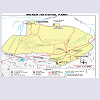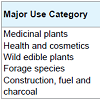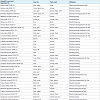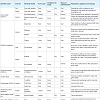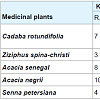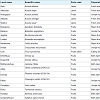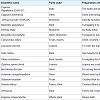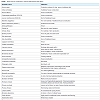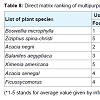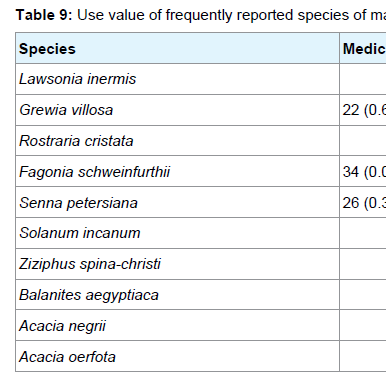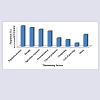Journal of Plant Biology & Soil Health
Download PDF
Research Article
*Address for Correspondence: Getaneh Gebeyehu, Department of Biology, Assosa University, P.O. Box 18, Assosa, Ethiopia, Tel: 0910176047; E-mail: getanehgebeyehu@yahoo.com
Citation: Beche D, Gebeyehu G, Feyisa K. Indigenous Utilization and Management of Useful Plants in and around Awash National Park, Ethiopia. J Plant Biol Soil Health. 2016;3(1): 12.
Citation: 2016 Gebeyehu G, et al. This is an open access article distributed under the Creative Commons Attribution License, which permits unrestricted use, distribution, and reproduction in any medium, provided the original work is properly cited.
Journal of Plant Biology & Soil Health | ISSN: 2331-8996 | Volume: 3, Issue: 1
Submission: 07 April, 2016 | Accepted: 27 May, 2016 | Published: 04 June, 2016
Indigenous Utilization and Management of Useful Plants in and around Awash National Park, Ethiopia
Dinkissa Beche1, Getaneh Gebeyehu2* and Kebenu Feyisa3
- 1Department of Biology, Samara University, Semera, Ethiopia
- 22Department of Biology, Assosa University, Assosa, Ethiopia
- 3Department of Natural Resource Management, Samara University, Semera, Ethiopia
*Address for Correspondence: Getaneh Gebeyehu, Department of Biology, Assosa University, P.O. Box 18, Assosa, Ethiopia, Tel: 0910176047; E-mail: getanehgebeyehu@yahoo.com
Citation: Beche D, Gebeyehu G, Feyisa K. Indigenous Utilization and Management of Useful Plants in and around Awash National Park, Ethiopia. J Plant Biol Soil Health. 2016;3(1): 12.
Citation: 2016 Gebeyehu G, et al. This is an open access article distributed under the Creative Commons Attribution License, which permits unrestricted use, distribution, and reproduction in any medium, provided the original work is properly cited.
Journal of Plant Biology & Soil Health | ISSN: 2331-8996 | Volume: 3, Issue: 1
Submission: 07 April, 2016 | Accepted: 27 May, 2016 | Published: 04 June, 2016
Abstract
An ethnobotanical study in and around Awash National Park with special emphasis on useful plants was conducted from September 2014 to August 2015. The study was aimed at documenting the indigenous knowledge of people on utilization and maintenance of cultural significance useful plants in their pastoral areas. Sixty-two useful plants belonging to 49 genera and 31 families were collected and identified from the study area. Most of plants investigated in the area have multiple uses which accounted to 54 species (87% of total plants). Totally, five useful plant categories were identified, including 35 medicinal species, 22 wild edible species, 39 forage species, 17 species for cosmetics and beauty and 45 species used for construction, fuel and firewood. In preference ranking of medicinal plants, Acacia negrii was ranked first followed by Acacia senegal to treat wound. Analysis of direct matrix ranking on multiple uses of seven species revealed that Boswellia microphylla, Ziziphus spina-christi and Balanites aegyptiaca were reported to be the most important and intensively used species in the community. Informant consensus factor analysis showed that construction, fuel and charcoal (72%) and wild edible plants (71%) had high informant agreement. In plant species level, informant consensus was higher for Rostraria cristata which was cited by 91.9% used for forages followed by Grewia villosa (72.5%) and Lawsonia inermis (62.9%) for different cosmetics in the society. In and around the Awash National Park, useful plants were facing threats in their natural habitats from various human activities. Population pressure followed by drought and agricultural expansion was found as the major threatening factors. The urgent actions are needed to conserve such vital plant resources. Further analysis of pharmaceutical and nutritional values of plants should be evaluated to optimize their wise use in the future.Keywords
Awash National Park; Ethnobotany; Indigenous knowledge; Useful plants; UtilizationIntroduction
The history of indigenous people depending on plants and utilization, physical and social environment shapes plant use and plant-human interaction. Ethnobotany is the study of this plant uman interrelationship embedded in dynamic ecosystem of natural and social components [1-4]. The role of plants reflects their biological and physical properties. The natural, anthropological, environmental and genetic factors limited responses of plants to human’s need. In the beginning, plant use was restricted to food, medicine and shelter, but later human beings have explored the potential of plants for a number of other purposes. Hence, human’s dependency on plants has increased both directly and indirectly [2].Human beings depend mainly on plants and to a less extent on animals for the basic requirements of their existence [3]. The indispensable dependence of humans on plants for their livelihoods primarily started with domestication and can be dated back to ten thousand years ago [4]. The collection of useful plants around homes must have gradually lead to small scale plants, whose continued intensification resulted in the emergence of full scale agriculturein gardens and fields [5]. Studying the relationship between people and plants and the significance of plant use knowledge towards the wellbeing of the community is extremely important [4,6].
Ethiopia is the home of amazing system of indigenous knowledge that supports people to survive under adverse environmental conditions, famine and poverty [7]. The country is also diverse in climatic conditions, topographic and edaphic variation that enableoccurrence of a wide range of vegetation from tropical rain and cloud forests to the desert scrubs [8]. Awash National Park is found in arid and semi-arid environment which is faced many problems from drought, population and livestock pressures. Two ethnic peoples (Oromo and Afar) live surrounding the Park and frequently compete on utilization of plant resources, which posed many problems on plant resources in the park as well as in the surrounding area before documentation on the importance of useful plants. Most previous studies in the site have been focused on plant diversity, composition and structure [9,10]. Therefore, it is very needed to document the local knowledge of communities on useful plants for the conservation and management of plant species in and around Awash National Park.
Materials and Methods
Description of the study areaAwash National Park is located at 9°20’N and 40°20’E. It is in the lowlands of Ethiopia at 215 Km North-East of Addis Ababa, covering an area of 756 Km2. The climatic condition of the park is arid and semi-arid, with an average annual rainfall of 620 mm.
The park serves as home of Ethiopia’s largest Beisa oryx population and is the second most important critical area, where some endangered, endemic and migratory bird species live. The presence of unique botanical features including Doum palm and riverine forests make the park attractive. The park is also characterized by unique landscape scenery and geological features including Fentale Crater,Ilala Sala plains and grasslands, Hot spring area and the gorge which represent an important income and food source for local communities. The Filwuha hot springs are important for curing illnesses such as malaria, the oldest educational museum and the lodges inside have diverse and unique ethnic/cultural features, including the Seats for Gada system and the Belaadas in Afar, an ideal place of a training site for ornithologists, primatologists and archaeologists and vital watering points for livestock, including Hakaki and the hot springs [11].
Socioeconomic of the two ethnic peoples
The park is surrounded by two regions; namely Afar (Awash Fantale district) and Oromia (Fantale district) regions (Figure 1). The Karrayyu and Ittu clans of Afan Oromo speakers found to the South and South West of the Park. The Karrayyu Oromo are pure pastoralists whereas the Ittu Oromo are agro-pastoralists. The Afar ribes are located at the North (Debene Clan) and East (Waima clan) of the park [12]. Pastoral agriculture is practiced mainly at an elevation below 1,500 m a.s.l. with annual rainfall of below 450 mm.In the arid zone, nomadic and semi nomadic pastoral livestock production depend on camels and goats as important components. In the semi-arid, semi-nomadic or semi-sedentary zone, livestock production is practiced. The major components of the livestock production are cattle and sheep, although camels and goats are found. Both water and range development is important element to improve livestock production here. Low moisture is the major production constraint particularly in the arid zone. In this zone, there is a high potential for irrigated agriculture, especially for production of fiber crops, sugar cane, oil seeds, horticultural and forage crops can be produced.
Data collection and identification methods
Ethnobotanical data were collected from four Kebeles in the surrounding areas of Awash National Park. The ethnobotanical data collection was based on semi structured interviews, field observation, preference and direct-matrix ranking [4,13]. A total of 60 informants (42 male and 18 female) were involved in the interview. In which, 15 key informants were identified by following systematic methodof informant selection [4,13] and other informants were selected randomly [13].
Preference ranking for five medicinal plants was analyzed to understand people perception on identification of efficacy plants. Direct matrix ranking for seven multiple uses of plants was analyzed to determine the main cause for overharvesting of the respectiveplants [4,13]. Identification of useful plant specimens collected from he study area was performed using taxonomic keys and Flora of Ethiopia and Eritrea [14-21] and deposited in Samara University.
Data analysis
Ethnobotanical data were entered into excel spreadsheet and ethnomedicinal uses and taxonomic groups were analyzed using descriptive statistics.The level of homogeneity between information provided by different informants was calculated using the Informants’ Consensus Factor (ICF) [22]. It is calculated as:  Where, Nur is the number of use reports from informants for a particular plant-usage category and Nt is the number of species that are used for that plant usage category for all informants. Values rangeetween 0 and 1, where ‘‘1’’ indicates the highest level of informant consent. In this study, five use categories for all informants reported frequently were chosen and consensus factors were calculated.
Where, Nur is the number of use reports from informants for a particular plant-usage category and Nt is the number of species that are used for that plant usage category for all informants. Values rangeetween 0 and 1, where ‘‘1’’ indicates the highest level of informant consent. In this study, five use categories for all informants reported frequently were chosen and consensus factors were calculated.
 Where, Nur is the number of use reports from informants for a particular plant-usage category and Nt is the number of species that are used for that plant usage category for all informants. Values rangeetween 0 and 1, where ‘‘1’’ indicates the highest level of informant consent. In this study, five use categories for all informants reported frequently were chosen and consensus factors were calculated.
Where, Nur is the number of use reports from informants for a particular plant-usage category and Nt is the number of species that are used for that plant usage category for all informants. Values rangeetween 0 and 1, where ‘‘1’’ indicates the highest level of informant consent. In this study, five use categories for all informants reported frequently were chosen and consensus factors were calculated.Use value of useful plants
Species importance was estimated by using use value analysis [23]. In the use value analysis, the plants were categorized into three classes, no use, minor use, and major use. The use value scores assigned to these classes were, 0, 0.5, and 1 respectively [23]. The lant use value was analyzed to evaluate the importance of each plant species to the ethnic people and calculated as the average use value of the species using the following formula:  Where, Uvis = the use value (Uv) attributed to a particular species (s) by one informant m (i); ΣUis = summation of all the uses mentioned in each event by the informant; nis = total number of events in which that informants give information on the species.
Where, Uvis = the use value (Uv) attributed to a particular species (s) by one informant m (i); ΣUis = summation of all the uses mentioned in each event by the informant; nis = total number of events in which that informants give information on the species.
 Where, Uvis = the use value (Uv) attributed to a particular species (s) by one informant m (i); ΣUis = summation of all the uses mentioned in each event by the informant; nis = total number of events in which that informants give information on the species.
Where, Uvis = the use value (Uv) attributed to a particular species (s) by one informant m (i); ΣUis = summation of all the uses mentioned in each event by the informant; nis = total number of events in which that informants give information on the species.Results and Discussions
Taxonomic diversityA total of 62 useful plant species belonging to 49 genera and 31 families were collected and identified from the study area. The family Fabaceae represented the highest number of species 11 species (18%), followed by Malvaceae and Solanaceae each with 5 species (8%),Acanthaceae with 4 species (6.4%), Asclepiadaceae and Cucurbitaceae each with 3 species (4.8%), Capparidaceae, Lamiaceae, Moraceae, Poaceae, Rhamnaceae and Tiliaceae each with two species. The growth form distribution showed that majority of the species were trees (35.5%, 22 species) followed by shrubs (25.8%, 16 species), herb (24%, with 15 species). Others were liana and climbers. More woody species recorded in the sites were because of higher adaptation of these plant species in the harsh environment than that of herbaceous species.
Major use categories and informant consensus factors
The result of the study showed that five major use categories of plants were recorded. From major use categories, 35 medicinal species which were used to the treatment of human, cattle, goat, heep and camel ailments; 22 wild edible species, 39 forage species, 17 cosmetics and beauty and 45 species used for construction, fuel and firewood (Table 1) were identified and documented on the base of their uses. The diversity of useful plants in the area was less compared with other regions [24-26]. This might be due to factors like over-exploitation and other environmental problems. The level of omogeneity between information provided by different informants was calculated using the Informants’ Consensus Factor [22]. Five reported use categories were frequently chosen and consensus factors were calculated (Table 1).Forage plants
The Awash National Park is a national park that surrounded by pastoralists’ people, who use a variety of habitats and plant species for their livestock feed. They utilize the surrounding area in a grazing mechanism. Thirty nine (62.9%) useful plants were used for forage,being distributed in 21 families and 33 genera. More than half (61%) of forage species belong to Poaceae, Fabaceae, Acanthaceae, Solanaceae, Tiliaceae, Capparidaceae, Cucurbitaceae, Malvaceae and Moraceae. The most important livestock feeds were documented, including trees 17 (43%), shrubs 9 (23%), herb 10 (26%), climber 2 (5%), liana 1(2.5%) species (Table 2). This was comparable with plant biodiversity of Borana Pastoralists [25] and higher in species number of forages with other regions [27]. This indicated that the knowledge of the people on the forage plants and their uses vary from lowland to highland. In the lowland area, pastoralists’ life depends on livestock production that utilized more forage species than sedentary agropastoralists.
Some forage plants, such as Rostraria cristata, Solanum campylacanthum and Polypogon viridis were highly utilized plants for livestock feed. Rostraria cristata was perceived as the best grass that tended to increase milk production and it was also the mostavailable grass type. The survey result from informants indicated that availability of pasture area has declined from time to time. The main reasons were increasing animal and human population, droughts, encroachment of pasture lands by invasive, especially Prosopis sp. high protection of national parks for wildlife protection and insecurity resulting from conflicts with other pastoral communities [28].
Medicinal plants
A total of 35 species (56.5% of the useful plants) belonging to 20 families and 30 genera were identified as medicinal plants (Table 3). Roots and Leaves were most frequently used parts followed by stems and fruits. Of the total medicinal plants, 23 species (66%) were usedas human medicine, five species (15%) as livestock medicine and the remaining seven species (20%) for treating both human and livestock ailments. These medicinal values attributed medicinal plants to be significant use category in the study area as similar studies have shown with other pastoralist in Ethiopia [24-26]. Medicinal tree species were accounted to the highest proportion being representing with 13 species (37 %) followed by herbs (10 sp., 29 %), shrub (5 sp., 14 %), climbers (4 sp., 11%) and lianas (3 sp., 9 %) (Figure 2). The result agreed with other study on medicinal plants in Ethiopia [25]. As most of people living in the rural area particularly in pastoralists’ had limited accessibility of modern medicine, traditional edicine might play highly important ways of ailment treatments. Such conditions had been forced pastoralists to depend on utilization of medicinal plants that might support to discover new productsfor modern medicine. However, availability of medicinal plants was declining in an alarming rate due to overexploitation and conflicts on the natural resource. In addition, uses of plant root parts for medicinal purpose suggested being another major problem in pastoralists as similar study has reported [29].
Preference ranking
Preference ranking of five medicinal plants that reported as effective for treating different kind of wounds was conducted after selecting 15 key informants. The informants were asked to compare the given medicinal plants based on their efficacy, and to give thehighest number ten for the medicinal plant which they thought the highest effective in treating wounds and the lowest number one for the least effective plant in treating wounds As shown in Table 4 below, Acacia negrii was scored the highest mark and ranked first indicating that it is suggested to be the most effective in treating wound followed by Acacia senegal. Ethnobotanical investigations done elsewhere in Ethiopia also reported that Acacia senegal has been used for different ethnomedicinal purpose [25]. Further pharmacological test of the species against wound curing might reveal promising results.Wild edible plants
The result of the study revealed that 22 wild edible species (35.5%) belonging to 17 genera and 15 families were documented in the site (Table 5). This indicated that the study area has potential source of wild edible species. Fabaceae had the highest proportion of edibleswith seven species, followed by Rhamnaceae and Tiliaceae accounted two species respectively. Most of the identified species were reported to be edible elsewhere in Ethiopia and in other countries of Africa. For example, of the species recorded in this study, eight species were documented elsewhere in Ethiopian lowlands [25]. Most plant parts were eaten directly in fresh forms. Out of total edible plants, nine species were commonly used in both ethnic groups. The Oromo (Ittu and Kereyyu) tribes affirmed that 10 (45%), and Afar (Wa’ema and Debene) 3 (14%) of the 22 edibles species in the study area. Utility of these species over wider areas among different communities indicated the existence of common knowledge across a range of subsistence groups of different culture and geographic areas. Analysis of the results indicated that majority of the recorded edible species were consumed in fresh without ripening or processing (Table 5).
Traditional fumigation and perfuming was a way by which female pastoralists use the smoke of some good-smelling aromatic species for cleaning their bodies and clothes. This traditional fumigation has advantages to clean bodies and make good smell which may beequivalent to modern perfumes. The most common species used for fumigations/cleansing include Cyperus rigidifolius, Boswellia microphylla and Solanum campylacanthum. Some species of plants in he area were used as hand lotion or coloring (e.g. Lawsonia inermis), body lotion (e.g. Delonix elata), steam bath (Fagonia schweinfurthii) that suggested to directly cleaning their skin in addition to perfuming. The most common type of cosmetics in the area were those plant species used for hair beauty and cleansing, such as Sida collina, Ziziphus spina-christi and Grewia villosa (Table 6), which were mostly prepared from fibers by crushing and soaking in water and using the foam to wash hair. These kinds of activities with similar species were reported from elsewhere [25,26,30].
The informants asserted that edible fruit bearing species such as Ziziphus spina-christi and Ximenia americana were highly prized by individuals in all age groups. The reasons for appreciation of one species over the other, assumed to be easiness to eat, nutritionalvalue and taste during consumption. In addition to food value, the identified species were marketable and provided the opportunity to supplement household income. This was observed in the study areas where various wild edible plants were sold at local market like fruits of Ziziphus spina-christi. The utilization of these species might gradually lead to the fading away of indigenous knowledge associated with the species and thus poses danger on poorer people who have relied on these cheap and relatively easily accessible food plants. Hence, many efforts need to promote the uses of these wild edibles through genetic and nutritional studies.
Health, cosmetics and beauty
The investigated 17 plant species have been commonly used for beauty and health purposes. Out of these, 13 species (62%) accounted to woody plants including trees, liana and shrubs (Table 6). Plants, which were used as laundry and cleansing, fumigation, fragranceand aromatic characters of the area, were documented. For example, the bulbs of Cyperus rigidifolius were collected from underground, pounded, and mixed with butter to make a local perfume to take care of their hairs (Table 6).
Plant uses for construction, fuel and charcoal
Different types of plant species have multiple values for uses of fuel, construction and charcoal production. Forty-five species elonging to 26 families, and 34 genera were recognized from thearea (Table 7). Out of these, woody plants (tree, shrub, and liana) comprised 37 species (82%), indicating that the woody plants were utilized more for different purposes than herbaceous plants in these categories. This showed that the Afar and Oromo ethnic people still depend on plant materials for house construction and other purpose. Furthermore, pastoralists depend on woods to make utensils for food preparation, containers (e.g. for farming material), and others (Table 8). Use value of useful plants
The use value was analyzed to evaluate the importance of each plant species to the ethnic people and calculated as the average use value of the species (Table 9). Such plants were intensively utilized by the pastoralists, and thus species availability might tend to decreaseand finally lead to local extinction. If these excessive or unsustainable harvesting practices continue, plant species may be put at risk. For example, Boswellia microphylla, one of the most highly affected plants for different uses, is now restricted to the top of mountains in distribution.As indicate above in Table 9, the frequently reported useful plants were analyzed for their informant’s consensus factor from each category. In this study, Rostraria cristata was cited by 91.9% of the informants for forage followed by Grewia villosa (72.5%) and Lawsonia inermis (62.9%) usage for different cosmetics in thesociety. From different ethnobotanical categories different levels of cultural consensus were recognized. Use value was the highest in the category of cosmetics for species Grewia villosa (0.63) and followed by Lawsonia inermis (0.6). This analysis indicated that people highly depend on certain number of species for major uses than other species, and some species of those with higher use value were well known within the ethnic groups. Therefore, further study on the chemical content and their management should focus on species commonly used in the ethnic groups.
Threatening factors of useful plants
The respondents from both ethnic groups indicated that different factors played to threaten useful plants in their area (Figure 3). The result of the study showed that population pressure (20%), drought (18.3%) and agricultural expansion (16.7%) were the major threatening factors to useful plants. Threatening factors of useful plants ere recognized as environmental condition such as drought and anthropogenic factors. Anthropogenic factors played the dominant role in surviving of plant species in the site. Human demands for sources of food, medicine, shelter, cosmetics, construction, charcoal production and forage for livestock resulted in overexploitation and overgrazing of plants. The majority of plants used for livestock feed revealed that overgrazing played dominant factor in the study areas.The results of the study showed that multiple utilizations of plants were recorded as the threatening factors similar to other previous studies in Ethiopia [31,32]. Therefore, most of the plant species in the areas have been facing lack of priorities for conservation especiallythe useful plants (medicinal, edible, forage plants). However, some farmers have started management of very few plants such as Ziziphus spina-christi and Balanites aegyptiaca in their farmlands. This showed that such management and acquisition of economic benefits from species might promote local peoples’ interest in conservation and maintenance of such local important plants.Such experiences should be exchanged with other local people to motivate conservation and anagement habit in the area.
Conclusions and Recommendations
The result of the study revealed that 62 useful plant species were found having vital roles in subsistence wellbeing to the society which was reflected by presence of five major use categories. The key products harvested from useful plants were edible parts, traditional medicine, forage, cosmetics and other miscellaneous benefits. The majority of products were found from woody species which were dominant useful plant components in the study area. The survival status of some useful species particularly in herbaceous plant species has declined.The major threatening factors for useful plants were recognized from environmental condition such as drought and anthropogenic activities. Anthropogenic activities took the dominant role and exerted many pressures on plant resources. Multiple uses of plantsfor charcoal production; forage uses and construction purpose made useful plants to be at risk conditions. These demand an urgent attention to conserve such vital resources. The rising awareness on utilization of plants in sustainable manner and minimization of conflicts in both ethnic groups might be promising solutions to reduce threatening factors. Therefore, conservation and management of useful plants should be regulated in collaboration and participation of local communities, districts, park reserves and federal administration.
A rich heritage of indigenous plant use and knowledge was recognized in almost similar manner in both ethnic groups. However, awareness rising for highly knowledgeable elders needed to avoid erosion of the indigenous knowledge and to ensure sustainable and preservation of indigenous knowledge for future generation. upporting the present investigation, pharmaceutical and nutritional value of plants should be further evaluated to optimize their use in the future. It is recommended that further studies in other ethnobotanical plant use categories should be conducted to capture the entire plant diversity that needs conservation priorities.
Acknowledgement
Authors acknowledged the local communities of Afar and Oromo Ethnic groups living around the park for sharing of their indigenous knowledge. We also acknowledged Samara University for financialsupport. Finally, we appreciated two anonymous reviewers for their valuable comments to improve the manuscript quality.References
- Alcorn BJ (1984) Huastec mayan ethnobotany. University of Texas Press, Austin, USA.
- Ali H, Qaiser M (2009) The ethnobotany of chitral valley, Pakistan with particular reference to medicinal plants. Pak J Bot 41: 2009-2041.
- Awas T, Demissew S, Bekele T (1997) Ethnobotanical study of non-cultivated plants in Gambella Region, Southwestern Ethiopia. In: Fukui K, Kurimito E, Shagaeta S (Eds). 13th, International conference on Ethiopian studies; Ethiopia in broader perspective. Kyoto, Japan 3: 759-774.
- Martin GJ (1995) Ethnobotany: a methods manual. Chapman and Hall, London, UK.
- Asfaw Z, Nigatu A (1995) Homegardens in Ethiopia: characteristics and plant diversity. Sinet: Ethiop J Sci 18: 235-266.
- Cotton CM (1996) Ethnobotany: principles and applications. John Wiley & Sons, UK.
- Fenta T (2006) Harnessing local and outsider’s knowledge: Experiences of multi-stakeholder partnership to promote farmer innovation in Ethiopia. Prolinnova working paper 12.
- Teketay D, Lemenih M, Bekele T, Yemshaw Y, Feleke S, et al. (2010) Forest resources and challenges of sustainable forest management and conservation in Ethiopia. In: Bongers F, Tennigkeit T (Eds). Degraded forests in Eastern Africa: management and restoration. Earthscan, London, UK, pp.19-63.
- Mekonnen M, Gebrehiwot K, Birhane E, Tewoldeberhan S (2009) Regeneration, density and diversity of woody vegetation in Awash National Park, Ethiopia. J Drylands 2: 101-109.
- Yohannes T, Awas T, Demissew S (2013) Woody plant species diversity analysis in Awash National Park, Ethiopia. J Biodiversity Manage Forestry 2: 1-7.
- Demeke Y, G/Tensa K (2011) Conference report on rescuing Awash National Park (Mat Pines, Ed). AdamaRas Hotel, Adama/Nazreth.
- Mohamed MA (1988) Resource deprivation and socio-economic changes among the pastoral households: the case of Karayu and Ittu pastoralists in the middle Awash valley of Ethiopia. Master Thesis, Agricultural University of Norway.
- Alexiades MN, Sheldon JW (1996) Selected guideline for ethnobotanical research: a field manual. New York Botanical Garden, New York.
- Edwards S, Hedberg I (1997) Flora of Ethiopia and eritrea. Hydrocharitaceae to Arecaceae, vol 6. National Herbarium, Biology Department of Science Faculty, Addis Ababa University, Ethiopia, Uppsala, Sweden.
- Edwards S, Tadesse M, Hedberg I (1995) Flora of Ethiopia and Eritrea. vol 2, part 2. Canellaceae to Euphorbiaceae. The National Herbarium, Addis Ababa, Ethiopia, Department of Systematic Botany, Uppsala, Sweden
- Edwards S, Tadesse M, Demissew S, Hedberg I (2000) Flora of Ethiopia and Eritrea. vol 2, part 1. Magnoliaceae to Flacourtiaceae. The National Herbarium, Addis Ababa, Ethiopia, Department of Systematic Botany, Uppsala, Sweden
- Hedberg I, Hedberg O, Egziabher TB, Edwards S, Uppsala universitet Institutionen för systematisk botanik (1989) Flora of Ethiopia and eritrea. vol 3, Pittosporaceae to Araliaceae. National Herbarium, Addis Ababa, Ethiopia, Department of Systematic Botany, Uppsala, Sweden.
- Hedberg I, Edwards S (1995) Flora of Ethiopia and eritrea. vol 7. Poaceae. The National Herbarium, Addis Ababa, Ethiopia, Department of Systematic Botany, Uppsala, Sweden.
- Hedberg I, Edwards S, Nemomissa S (2003) Flora of Ethiopia and Eritrea. vol 4, part 1. Apiaceae to Dipsacaceae. The National Herbarium, Addis Ababa, Ethiopia, Department of Systematic Botany, Uppsala, Sweden.
- Hedberg I, Friis I, Edwards S (2004) Flora of Ethiopia and Eritrea, vol 4, part 2. Asteraceae. The National Herbarium, Addis Ababa, Ethiopia, Department of Systematic Botany, Uppsala, Sweden.
- Hedberg I, Kelbessa E, Edwards S, Demissew S, Persson E (2006) Flora of Ethiopia and Eritrea vol 5, Gentianaceae to Cyclocheilaceae. The National Herbarium, Addis Ababa, Ethiopia, Department of Systematic Botany, Uppsala, Sweden.
- Trotter RT, Logan MH (1986) Informant consensus: a new approach for identifying potentially effective medicinal plants. In: Etkin NL (Ed). Plants in indigenous medicine and diet: biobehavioral approaches. Redgrave Publishing Company, Bedfort Hills, New York, pp. 91-112.
- Phillips O (1996) Some quantitative methods for analyzing ethnobotanical knowledge. In: Alexiades MN (Ed). Selected guidelines for ethnobotanical research: a field manual. New York Botanical Garden, New York, pp. 171-197.
- Seifu T, Asres K, Gebre-Mariam T (2004) Ethnobotanical and ethnopharmaceutical studies on medicinal plants of Chifra District, Afar Region, North Eastern Ethiopia. Ethiop Pharm J 24: 41-58.
- Gemedo-Dalle T, Maass BL, Isselstein J (2005) Plant biodiversity and ethnobotany of Borana pastoralists in southern Oromia, Ethiopia. Economic Botany 59: 43-65.
- Lulekal E, Kelbessa E, Bekele T, Yineger H (2008) An ethnobotanical study of medicinal plants in Mana Angetu District, Southeastern Ethiopia. J Ethnobiol Ethnomed 4: 1-10.
- Yineger H, Yewhalaw D, Teketay D (2008) Ethnomedicinal plant knowledge and practice of the Oromo ethnic group in southwestern Ethiopia. J Ethnobiol Ethnomed 4: 11.
- Philpott J, Abera A, Hadgu K (2005) Livelihoods/Emergency assessment in Afar Region. Oxfam International.
- Piguet F (2002) Afar: insecurity and delayed rains threaten livestock and people. Emergencies Unit for Ethiopia (UN-EUE). Addis Ababa.
- Cunningham AB (1996) People, park and plants use: recommendations for multiple use zones and development alternatives around Bwindi: Impenetrable National Park, Uganda. In: People and plants working paper 4: 18-25.
- Gebeyehu G, Asfaw Z, Enyewu A, Raja N (2014) An ethnobotanical study of traditional medicinal plants and their conservation status in Mecha Woreda, West Gojjam Zone of Ethiopia. Int J Phram H Care Res 2: 137-154.
- Mengesha GG (2016) Ethnobotanical survey of medicinal plants used in treating human and livestock health problems in Mandura Woreda of Benishangul Gumuz, Ethiopia. Adv Med Plant Res 4: 11-26.


